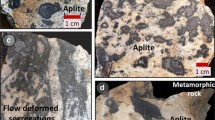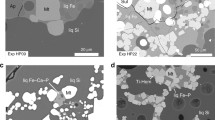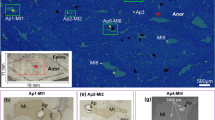Abstract
Globules of iron-dominated (59–69 wt% FeOtot) and titanium-dominated (43.5 wt% TiO2) oxide melts have been detected in igneous xenoliths from Pliocene-to-Pleistocene alkali basalts of the Western Carpathians. Fluid inclusion and mineral composition data indicate immiscible separation of the high-iron-oxide melt (HIM) at magmatic temperatures. The HIM separation occurred during clinopyroxene (augite) accumulation in an alkali trachybasalt and continued during crystallization of amphibole (kaersutite) and K-feldspar (anorthoclase), the latter coexisting with trachyte and alkalic rhyolite residual melts. Some HIM was also expelled from sub-alkalic rhyolite (70–77% SiO2), coexisting with An27–45 plagioclase and quartz in granitic (tonalite-trondhjemite) xenoliths. Oxygen fugacities during HIM separation range from −1.4 to +0.6 log units around the QFM buffer. A close genetic relationship between HIM-hosted xenoliths and mantle-derived basaltic magma is documented by mineral 18O values ranging from 4.9 to 5.9‰ V-SMOW. δD values of gabbroic kaersutite between −61 and −86‰ V-SMOW are in agreement with a presumed primary magmatic water source. Most trace elements, except Li, Rb and Cs, have preferentially partitioned into the HIM. The HIM/Si-melt partition coefficients for transition elements (Sc, V, Cr, Co, Ni) and base metals (Zn, Cu, Mo) are between 2–160, resulting in extreme enrichment in the HIM. La and Ce also concentrate in the silicic melt, whereas Tb-Tm in the HIM. Hence, the immiscible separation causes REE fractionation and produces residual silicic melt enriched in LREE and depleted in HREE. The weak fractionation among Tb-Tm and Yb, Lu can be attributed to recurrent extraction of the HIM from the magmatic system, while flat HREE chondrite-normalized patterns are interpreted to indicate no or little loss of the HIM.
Similar content being viewed by others
Author information
Authors and Affiliations
Additional information
Received: 30 September 1997 / Accepted: 23 March 1998
Rights and permissions
About this article
Cite this article
Hurai, V., Simon, K., Wiechert, U. et al. Immiscible separation of metalliferous Fe/ Ti-oxide melts from fractionating alkali basalt: P-T-f O2 conditions and two-liquid elemental partitioning. Contrib Mineral Petrol 133, 12–29 (1998). https://doi.org/10.1007/s004100050433
Published:
Issue Date:
DOI: https://doi.org/10.1007/s004100050433




